During the early 20th century, covered wagons and horse-drawn sleighs pulled up to the doors of the tiny Stevensville Post Office so rural route mail carriers could load up and deliver the mail from Kent Island’s Love Point to Kent Point.
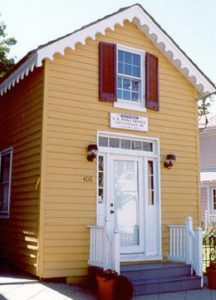 As in many small towns, the Old Stevensville Post Office served as a gathering spot for townspeople to share news or pass the time. The little shot-gun-style building, which was first noted on an 1877 map, served as the Stevensville Post Office until the 1950s. Old records show that at one time the government paid rent of $18.75 per month and it cost $25 per year to heat the 730 square foot building.
As in many small towns, the Old Stevensville Post Office served as a gathering spot for townspeople to share news or pass the time. The little shot-gun-style building, which was first noted on an 1877 map, served as the Stevensville Post Office until the 1950s. Old records show that at one time the government paid rent of $18.75 per month and it cost $25 per year to heat the 730 square foot building.
Situated on the east side of Love Point Road in Historic Stevensville, the Old Stevensville Post Office was acquired by the Kent Island Heritage Society in 1997. Gold in color, gable end to the street, and trimmed with white gingerbread eaves, the Old Stevensville Post Office continues to serve as the society’s headquarters.
Glimpse rural life of the past at Queen Anne’s Museum of Eastern Shore Life where you’ll find a unique collection of antique farm implements and tools, equipment used by watermen to harvest the Bay’s bounty, Indian artifacts, and household items. A real blacksmith shop is reconstructed here giving visitors a peek into the past.
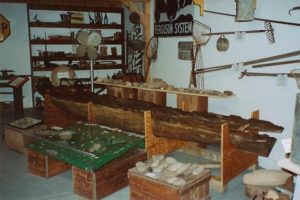 Among the museum’s most recent acquisitions are a log canoe, pictured to the left, and a complete print shop from the late 1800’s.
Among the museum’s most recent acquisitions are a log canoe, pictured to the left, and a complete print shop from the late 1800’s.
It is said that Church Hill gained its name from this gorgeous brick church that is perched upon the high ground. The church on the hill, or St. Luke’s Episcopal Church, is one of the oldest intact brick church in the state having been built in 1732 at a cost of 140,000 pounds of tobacco. That tobacco paid for bricks to be brought over from England to replace the wooden church that had been erected in 1728. The bricks were laid in a handsome Flemish bond pattern.
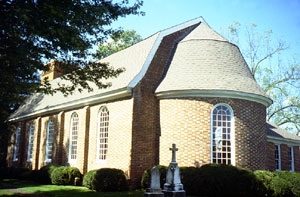 During the Civil War, Federal troops reportedly used the church as a barracks, and allegedly damaged the interior, although no record appears in Vestry minutes of expenditures to replace pews or windows. In fact, by the close of the war, pews were rented to families for $25 a year.
During the Civil War, Federal troops reportedly used the church as a barracks, and allegedly damaged the interior, although no record appears in Vestry minutes of expenditures to replace pews or windows. In fact, by the close of the war, pews were rented to families for $25 a year.
The church retains its historic 1735 gift from the Queen Anne’s Bounty Fund – two wooden tablets with gold letters containing the Lord’s Prayer, the Apostle’s Creed, and the Ten Commandments. According to church minutes, these tablets were old when they were originally given to the Church.
On the church grounds is a small brick building built in 1817 as the parish academy. The school was built to help supplement the rector’s salary, as he also served as teacher for the school.
One of the most unique structures on the Eastern Shore, this National Register site is located on a tract of land once called Steven’s Adventure, granted to Francis Stevens in 1694. Built c. 1809, the Cray House is a rare example of post-and-plank construction, where hand-sawn logs are mortised and tenoned into vertical corner posts, forming the sides of the building.
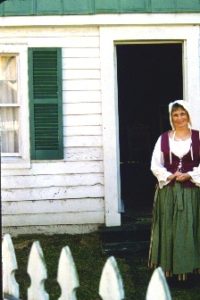 It is one of a handful of post-and-plank buildings to survive in Maryland and is also important as a rare survival of the small, two-room plan houses that were a dominant part of the pre-industrial landscape. In this case, the hall-parlor plan had only one heated room on each floor, yet despite the modest size, the house was finished with a full complement of interior trim, including beaded board partition, beaded baseboards, a two-piece chair rail, refined trim and first-floor mantel.
It is one of a handful of post-and-plank buildings to survive in Maryland and is also important as a rare survival of the small, two-room plan houses that were a dominant part of the pre-industrial landscape. In this case, the hall-parlor plan had only one heated room on each floor, yet despite the modest size, the house was finished with a full complement of interior trim, including beaded board partition, beaded baseboards, a two-piece chair rail, refined trim and first-floor mantel.
The house was sold at public auction in 1914 and was lived in by Nora Cray, a widow, along with her three children. In 1975 her heirs donated the house and lot to the Kent Island Heritage Society, who have restored and furnished it. The meat house in the rear, although moved to this site, is a rare example of what was once a common feature of houses in the region.
Entering Queenstown’s Courthouse is like stepping through a portal in time. Much of your surroundings are original, such as the horizontal oak wall sheathing and some of the weatherboarding on the end walls. The flooring, originally a typical earth floor, was later updated to wood. The frame structure dates to 1708 and the brick section was added between 1820 and 1840, well after the 1782 transfer of the county seat to Centreville.
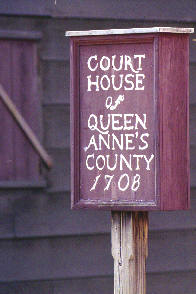 It was at this court in 1765 that William Paca was admitted to practice law in Queen Anne?s County. It was also here in 1718 that a whipping post was erected and Katharine Langton was given 20 lashes, and others were confined to the stocks, branded, or faced the hangman’s noose at nearby Gallows Field, which had been located just south of the courthouse.
It was at this court in 1765 that William Paca was admitted to practice law in Queen Anne?s County. It was also here in 1718 that a whipping post was erected and Katharine Langton was given 20 lashes, and others were confined to the stocks, branded, or faced the hangman’s noose at nearby Gallows Field, which had been located just south of the courthouse.
When the county seat was moved to Centreville in 1782, the courthouse was used for various purposes. The town bought the property in 1977 and the restoration of the colonial courthouse was completed in the late 1970s.
The Queen Anne’s County Courthouse boasts a long heritage as the oldest Maryland courthouse in continuous use. Completed in 1792, the white brick courthouse had a center section two rooms deep, flanked by matching wings one room deep. The building was renovated in 1876 and the wings were doubled in depth and a rear addition was added. Upstairs, today’s circuit court cases are heard beneath a coffered tin ceiling that is supported by cast iron columns from the Victorian Era renovations. During the cold war, a bomb shelter was built in the basement. The courthouse is a fully functional working environment with current documents sitting beside dusty old volumes recording the indentures of servants.
 The courthouse green is the town’s centerpiece and the green itself is graced with a sculpture of the county’s namesake, Good Queen Anne. Her Royal Highness Princess Anne of England attended the statue’s 1977 dedication. This is the only known sculpture of Queen Anne outside of England. Also on the courthouse green is the county’s war memorial wall that lists the names of each Queen Anne’s County citizen who died fighting for the country.
The courthouse green is the town’s centerpiece and the green itself is graced with a sculpture of the county’s namesake, Good Queen Anne. Her Royal Highness Princess Anne of England attended the statue’s 1977 dedication. This is the only known sculpture of Queen Anne outside of England. Also on the courthouse green is the county’s war memorial wall that lists the names of each Queen Anne’s County citizen who died fighting for the country.
A superb example of the Queen Anne style of ecclesiastical architecture and also one of the most carefully preserved Victorian Churches in Maryland, Christ Church, on Stevensville’s Main Street, is an historic gem. Christ Church attests to Kent Island’s importance as the cradle of the Anglican Church in Maryland ‘ being the site of the earliest Anglican settlement in the colony.
The congregation was first established at Claiborne’s settlement at Kent Point in the 1630’s and the present building, constructed in 1880, is the fourth known church to be constructed by the parish. In 1995, the congregation relocated to a new, larger, facility on Rt. 8. Christ Church continues to be used as a house of worship.
The 1880 church is distinguished by a steep slate roof, and an unusual chimney designed in the medieval ‘lancet’ style and is garnished with simple yet pleasing stained glass windows arranged in three pairs along each side wall with larger arched windows in the south gable behind the altar. The bell tower adjoins the east facade. The church’s dramatic interior is dominated by the steeply pitched ceiling that rises heavenward above the congregation and is supported by open, stick-style trusses that divide the building into four bays.
The church’s dramatic interior is dominated by the steeply pitched ceiling that rises heavenward above the congregation and is supported by open, stick-style trusses that divide the building into four bays.
The site of the 1652 Broad Creek Church and Cemetery, where three of the Christ Church congregation’s previous structures once stood, is located off Route 8 in Stevensville. The cemetery is currently being restored and is undergoing an archaeological investigation by Christ Church Parish. The cornerstones of the 1652 church have been unearthed, as well as 12 burial headstones, dating from 1746 to 1903.
For more information, visit friendsofhistoricchristchurch.org
 As in many small towns, the Old Stevensville Post Office served as a gathering spot for townspeople to share news or pass the time. The little shot-gun-style building, which was first noted on an 1877 map, served as the Stevensville Post Office until the 1950s. Old records show that at one time the government paid rent of $18.75 per month and it cost $25 per year to heat the 730 square foot building.
As in many small towns, the Old Stevensville Post Office served as a gathering spot for townspeople to share news or pass the time. The little shot-gun-style building, which was first noted on an 1877 map, served as the Stevensville Post Office until the 1950s. Old records show that at one time the government paid rent of $18.75 per month and it cost $25 per year to heat the 730 square foot building. Among the museum’s most recent acquisitions are a log canoe, pictured to the left, and a complete print shop from the late 1800’s.
Among the museum’s most recent acquisitions are a log canoe, pictured to the left, and a complete print shop from the late 1800’s. During the Civil War, Federal troops reportedly used the church as a barracks, and allegedly damaged the interior, although no record appears in Vestry minutes of expenditures to replace pews or windows. In fact, by the close of the war, pews were rented to families for $25 a year.
During the Civil War, Federal troops reportedly used the church as a barracks, and allegedly damaged the interior, although no record appears in Vestry minutes of expenditures to replace pews or windows. In fact, by the close of the war, pews were rented to families for $25 a year. It is one of a handful of post-and-plank buildings to survive in Maryland and is also important as a rare survival of the small, two-room plan houses that were a dominant part of the pre-industrial landscape. In this case, the hall-parlor plan had only one heated room on each floor, yet despite the modest size, the house was finished with a full complement of interior trim, including beaded board partition, beaded baseboards, a two-piece chair rail, refined trim and first-floor mantel.
It is one of a handful of post-and-plank buildings to survive in Maryland and is also important as a rare survival of the small, two-room plan houses that were a dominant part of the pre-industrial landscape. In this case, the hall-parlor plan had only one heated room on each floor, yet despite the modest size, the house was finished with a full complement of interior trim, including beaded board partition, beaded baseboards, a two-piece chair rail, refined trim and first-floor mantel. It was at this court in 1765 that William Paca was admitted to practice law in Queen Anne?s County. It was also here in 1718 that a whipping post was erected and Katharine Langton was given 20 lashes, and others were confined to the stocks, branded, or faced the hangman’s noose at nearby Gallows Field, which had been located just south of the courthouse.
It was at this court in 1765 that William Paca was admitted to practice law in Queen Anne?s County. It was also here in 1718 that a whipping post was erected and Katharine Langton was given 20 lashes, and others were confined to the stocks, branded, or faced the hangman’s noose at nearby Gallows Field, which had been located just south of the courthouse. The courthouse green is the town’s centerpiece and the green itself is graced with a sculpture of the county’s namesake, Good Queen Anne. Her Royal Highness Princess Anne of England attended the statue’s 1977 dedication. This is the only known sculpture of Queen Anne outside of England. Also on the courthouse green is the county’s war memorial wall that lists the names of each Queen Anne’s County citizen who died fighting for the country.
The courthouse green is the town’s centerpiece and the green itself is graced with a sculpture of the county’s namesake, Good Queen Anne. Her Royal Highness Princess Anne of England attended the statue’s 1977 dedication. This is the only known sculpture of Queen Anne outside of England. Also on the courthouse green is the county’s war memorial wall that lists the names of each Queen Anne’s County citizen who died fighting for the country.